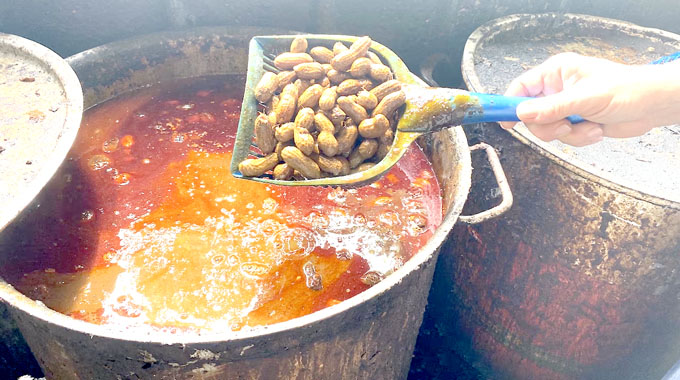By Kelly Kazek
Are boiled peanuts so important to our culture we need to honor them with a historical marker? Of course. And, as far as I can determine, Alabama is the only state to have such a marker.
It was erected with the aid of the William G. Pomeroy Foundation and the Hungry for History program on the campus of Troy University’s Dothan campus in 2023.
The Hungry for History program is offers grants for markers that highlight food history “by telling the stories of local and regional food specialties” and “commemorate significant food dishes created prior to 1970 and the role they played in defining American culture and forging community identity.” Because Alabamians and southerners find so much of our identity in food, I expect to see more of these markers across the state.
This marker says:
Boiled Peanuts
As early as 1907, salted green peanuts boiled in brine were sold during the summer months throughout Dothan, “Peanut Capital of the World.”
You can see it at 500 University Drive, Dothan.
I get that there’s room for only so many words but, really, boiled peanuts deserve so much more. (And, by the way, for the uninitiated, in the world of peanuts, “green” means freshly dug with no moisture removed.)
Let’s discuss how boiled peanuts came to be a southern staple. First off, they came to the United States, and likely to the Mississippi/Alabama territories, well before 1907 and even before the 1860s.
They didn’t originate in the Civil War as cheap and nutritious food for soldiers. That legend is attached to most every southern food, and every dish that’s thought to be southern in origin. In most cases, old southern dishes came instead from Africa, brought to the colonies by enslaved people. That’s the case with boiled peanuts, according to Robert Moss in an article on Serious Eats.
Moss wrote: “The legumes made their way to the British Colonies in the South and the Caribbean on slave ships, which were frequently provisioned with peanuts for the deadly Middle Passage. By 1754, Gardner’s Dictionary noted that ‘all the settlements in America abound with it; but many persons who reside in that Country affirm, they were originally brought by the Slaves from Africa there.”
By 1946, boiled peanuts were fully initiated into southern culture and considered an oddity to northerners. A headline in The Star Press in Indiana on Sept. 8 of that year said: “Peanut Pointers for Damyankees.” The first sentence said:
“It’s boiled peanut time again – the season in which hundreds of unsuspecting Yankees are taken by surprise by the soggy Dixie delicacy….and when he opens the shells to discover the nuts inside are soft and pulpy, instead of being crisp and firm, he’s likely to turn to the nearest southerner for an explanation.”
Here are some ways boiled peanuts have been discussed in newspapers over the years:
As a Congressional bill, 1963:
Congress has discussed boiled peanuts numerous times over the years, mainly as part of agriculture bills, but always with interesting results. In 1963, the Associated Press reported that Kennedy had signed a boiled peanut bill into law. It extended an acreage exemption for peanuts grown for boiling as opposed to peanuts grown for regular peanut things. But not everyone was on board, with one member saying “he had offered boiled peanuts to the notoriously finicky pigeons on the Capitol grounds and the birds had turned away.”
The Enterprise, Ala., Ledger reported: “The acoustics of boiled peanuts are an invaluable asset. Boiled peanuts have a velvety sound when opened in a theater. No munchy, crackling or popping noises that distract neighbors, like parched or roasted peanuts. They may even be eaten in bed with absolute comfort and safety.”
As a veggie, 1965:
The Tallahassee, Fla., Democrat argues on behalf of the boiled peanut being a vegetable: “There is justification for the official designation of boiled peanuts as vegetables. You can get them in cans, like asparagus or artichokes. The first we saw were put up over at Havana by a cannery they specialized in such things as collared greens, turnip greens, blueberries and boiled peanuts…”











